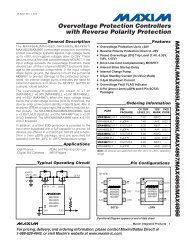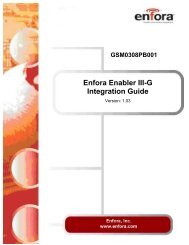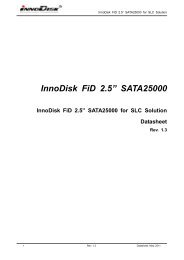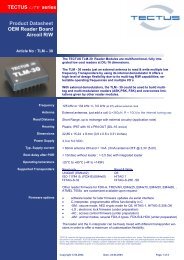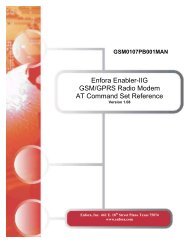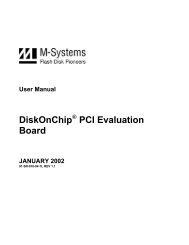AT+i Programmer's Manual - SE Spezial-Electronic AG
AT+i Programmer's Manual - SE Spezial-Electronic AG
AT+i Programmer's Manual - SE Spezial-Electronic AG
You also want an ePaper? Increase the reach of your titles
YUMPU automatically turns print PDFs into web optimized ePapers that Google loves.
Secure Socket Protocol Theory of Operation<br />
openssl req –newkey rsa:1024 –keyout myprivkey.pem –keyform PEM –out<br />
myreq.pem –outform PEM<br />
If you do not want an encrypted private key, add –nodes to the above command. At the<br />
conclusion of this step two new files are created. The myprivkey.pem file contains the<br />
encrypted private key. This file must never be shared, not even with the CA. The other<br />
file is the certificate request file, myreq.pem, which will be used by the CA to create the<br />
final signed certificate.<br />
31.5.2 Using the Test CA to Issue the Certificate<br />
The final step of the process is to use the CA self-signed certificate to sign the certificate<br />
and return it to the originator of the request (subject).<br />
1. Reset the OPENSSL_CONF system environment variable to reference the CA<br />
configuration file again.<br />
On Linux\Unix type the following:<br />
OPENSSL_CONF=/testCA/CAcnf.cnf<br />
export OPENSSL_CONF<br />
On Windows type the following:<br />
set OPENSSL_CONF=C:\testCA\CAcnf.cnf<br />
Make sure that the request file is in the current directory and run the following command.<br />
The PEM password you are prompted to enter is the password for the CA private key file:<br />
openssl ca –in myreq.pem<br />
You will be requested to enter the pass phrase for the CA private key that was generated<br />
above. Enter the pass phrase to continue.<br />
Answer ‗y‘ at the next two prompts, then at the conclusion of this step several files are<br />
updated and a new certificate is created.<br />
The new certificate can be found in the certs sub-directory. It is named as the serial<br />
number it is associated with by the CA. The file can be renamed, but the .pem extension<br />
must be preserved for clarity. The serial file itself increments its count for the next<br />
certificate request and the index.txt file shows a record of the creation. The new<br />
certificate file and the myprivkey.pem file are now suitable for use by an SSL server to<br />
which iChip needs to connect. As mentioned above, the iChip +iCA parameter must<br />
contain the CA certificate cacert.pem used to sign the server‘s certificate.



